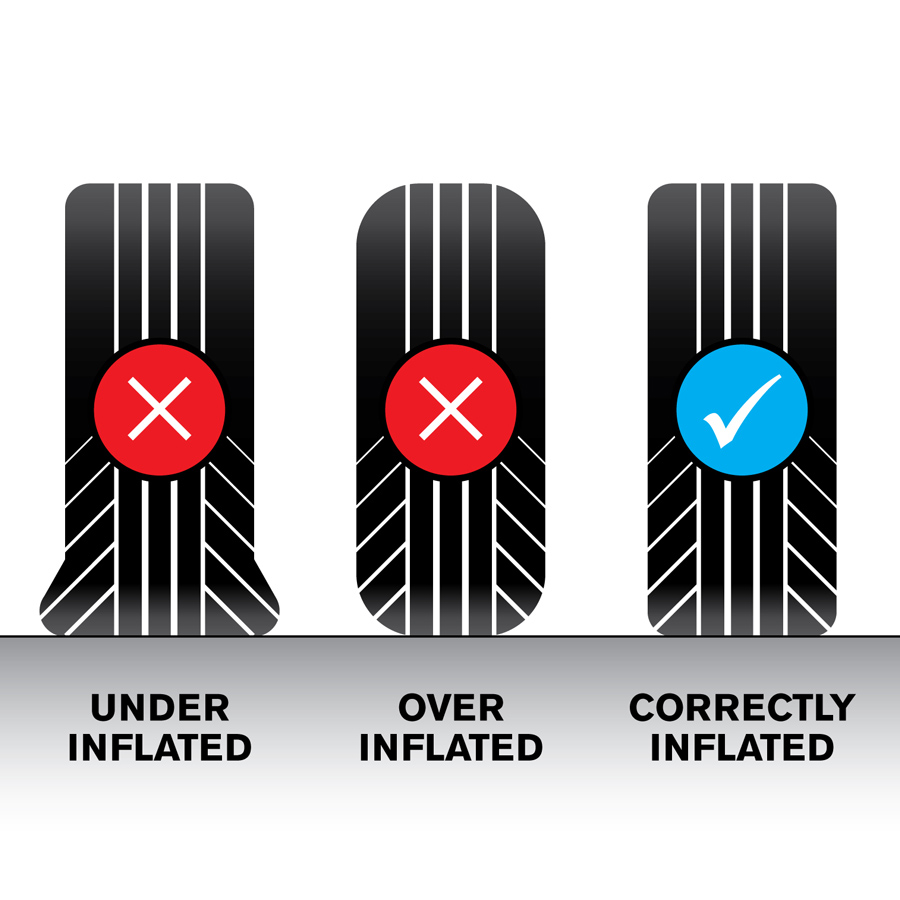How to maintain your car tyres
Why does tyre maintenance matter?
Your tyres are the only part of your car that is in contact with the road – so keeping them in good shape is vital for driving safely.
Well-maintained tyres will maximise the surface area contact with the road, so your car has better grip and manoeuvrability. They also reduce stopping distances – so if you do need to brake in an emergency, your car will come to stop more quickly, helping you avoid a dangerous situation. Tyres in good shape also make it safer when driving in wet weather – a common occurrence in the UK.


Correctly maintained tyres will also mean you:
- Stay legal. It is illegal to drive with tyres that have a tread depth of less than 1.6mm – you can face a fine of £2,500 per tyre if you are caught driving with tyres below the legal tread depth.
- Save money. Having well-maintained tyres helps you drive more efficiently – meaning you use less fuel, saving you money at the pumps. A tyre that’s under inflated by 10% increases fuel consumption by 2%.
- Cut your carbon emissions. With fuel savings come carbon savings. Studies suggest that over 600,000 tyres and 1.5 million tonnes of CO2 are wasted in the UK every year due to tyre under-inflation.
How to look after car tyres
There are three things to consider when looking after your car tyres. These are simple checks, but can make a big difference when you’re driving.

Tyre condition
Look over your tyres, to see their general condition. Things to look out for are any lumps, bumps or bulges. These could mean the tyre is damaged – if you notice any then take your car to a tyre specialist for them to take a look.
Also look for any items stuck in the tyres, and remove any stones lodged in the tread. And it’s worth making sure they are nice and clean – and especially that there is no oil or grease on them.

Tyre tread
Having deep enough tyre tread makes a huge difference to your safety when driving. Deeper tread reduces stopping distance and makes your tyres more effective in wet weather.
- A car with 8mm of tread, driving at 30mph on a wet road, will come to a stop in 25.9m.
- The same car driving in the same conditions but with 3mm tyre treads would stop in 35m.
That’s 35% more. - When the tyres reach 1.6mm of tread – the legal minimum – the stopping distance increases to 43m
It’s easy to see that in an emergency situation, tyre tread could make all the difference. Is it recommended that you replace your tyres once your tread gets below 3mm. However, your tyres are not illegal until the tread is less than 1.6mm. If you are caught by police with tread under this, you could be fined £2,500 per tyre. Your car will also not pass its MOT with illegal tyre tread.
How to check your tyre tread
As you use your tyres, the tread will wear away, so you need to check regularly that it is still at a safe depth. Fortunately, this is easy to do. We recommend using a tread depth gauge. These handy devices often come included with a tyre pressure gauge. To check the tread depth, simply:
- Place the depth gauge on the surface of the tyre, so the measuring needle can sink into the tread.
- The measuring needle will show the tread depth.
- You need to have at least 1.6mm in the middle three quarters of the tyre, and be consistent all the way round the tyre.
- It’s recommended to check three spots on each tyre, just to be sure.

Tyre pressure
Tyre pressure can also make a big difference when it comes to safer driving. Properly inflated tyres give the optimum surface area contact with the road – under or overinflated tyres reduce the grip when driving.
How to check your tyre pressure
To check your tyre pressure, you need either a tyre inflator or a tyre pressure gauge.
- Before you start, check the recommended tyre pressure. You can find your tyre pressure either in the driver’s door, on the inside of the fuel tank flap or in your vehicle handbook. Note: if your car is heavily loaded (if it’s fully packed for a holiday perhaps), you may need to increase your tyre pressure.
- Remove the tyre dust cap. Keep this safe while you check your pressure.
- Attach your tyre pressure gauge or inflator. Check the screen or gauge.
- Make sure you check your tyre pressure regularly, and before long journeys.

How to inflate your tyres
The simplest and easiest way to top up your tyre pressure is with a tyre inflator. The portable, easy-to-use devices can be powered directly from your in-car 12V socket, or are cordless: either way, it means you can inflate when you need to.
Basic inflators are simple start/stop devices with an analogue dial. You attach to the tyre, press start and it inflates. These entry-level models tend to take longer to inflate – up to 5 minutes to inflate a 13” tyre from flat to 35PSI.
A digital tyre inflator has several advantages. Many come with a large, backlit display, clearly showing the tyre pressure reading in the units of your choice (usually PSI, kPA or bar), which makes it easier to get an accurate pressure. They tend to be faster, inflating a 13” tyre from flat to 35PSI in around 2 minutes. They also come with handy extras like cases, longer cables and hoses making them easier to use with larger vehicles, and LED lights to use at night.
For the easiest inflation, a cordless, rechargeable inflator is the best option. With no trailing cables and no need to connect to the 12V socket, it’s easy to get to each tyre and inflate to the optimal pressure.

 Free Delivery On Orders Over £25*
Free Delivery On Orders Over £25* Pay In Three Available Over £30
Pay In Three Available Over £30 Two Year Guarantee Included*
Two Year Guarantee Included*